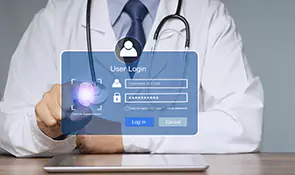
An active healthcare license is crucial for medical practice because, without an active license, doctors cannot practice. Practicing medicine with an expired license can cause the initiation of legal action against you.
Digitalization has a significant impact on every industry, the healthcare sector is no exception. The ease of finding things online has made people dependent on it. Using this digital power patients can check the credentials of their doctors online.
While an active physician license builds credibility among your potential patients. An expired license forbids you from practicing medicine legally in the country.
Sometimes remembering licensing dates and other documents can be difficult. To ease this difficulty physicians must frequently undergo license look-ups.
But before understanding how to run a license look let us understand what a physician look-up is.
Medical license requirements vary from state to state. While the requirement varies you must ensure that your license is active to practice medicine. To ensure this necessity physicians must run a medical license look-up once in a while to ensure that their license is active.
A medical license lookup is a software tool that helps doctors to ascertain the status of their license.
All potential physicians must pass the United States Medical Licensing Examination, or USMLE before they can practice medicine in the country. This standardized test tests their knowledge of health and disease management and effective patient care. Applicants must provide proof of their education and training, and provide details about their work history.
Once applicants have passed this exam, they must apply for a license from a state medical board. The state board will determine whether an applicant is eligible to practice medicine in the state where he or she wishes to practice.
Physicians must meet certain requirements to obtain a medical license. In general, they must:
* Meet state qualifications
* Be a graduate of an approved medical school
* Pass the licensing exam
* Show that they have been practicing medicine for a certain amount of time
Having an active state license is essential to practice in a state. While every state has its licensing procedure and requirements a doctor must comply with those requirements. If a doctor fails to have an active medical license the state forbids them to practice medicine legally.
To ensure your practice is not affected because of expired licenses physicians must regularly run Physician License Look-ups. These online medical license look-up tools help doctors to know about the status of their licenses.
If you are looking for license look-up services please reach out to CrediDocs which offers medical license look-up services.
Ref:
FSMB | About Physician Licensure

Medical licenses are one of the essential components of the healthcare system and guarantee that only competent people can practice medicine. Apart from confirming the competence and competence of doctors, and, thus, safeguarding the population and encouraging faith in the medical discipline, these licenses are also verification of doctors’ skills. However, violation of a medical license may attract severe penalties, cancellation of licenses, fines, and also criminal charges.
This article aims to explore everything about medical license suspension including the causes, the possible consequences, and the procedure of prevention.
Every state has its medical board that oversees the practice of medicine and ensures that the licensed practicing physicians meet set criteria to protect the health of the public. They also issue medical doctor licenses, inquire into complaints concerning physicians, punish those physicians who violate the Health Practice Act, protect the health of patients, conduct the United States Medical Licensure Examination, and establish and enforce requirements for medical licensure.
A medical license usually never expires, but it has to be renewed frequently, depending on the state. The physicians are required to complete CME programs, indicate proof of practice malpractice insurance, update personal and practice information, and pay license renewal fees. They also can achieve up-to-date knowledge on advances in medicine as well as the continued competence of practitioners.
People should go for continuing education because it helps the doctors to learn about the new treatments or research that has deal with the illness. As for those who have had problems with physician license renewal, there is an opportunity to get a medical license waiver, which may help to fulfill all the conditions for practicing.
A suspension of the physician license is a severe penalty that a care provider may receive due to professional misconduct, unethical behavior, or criminal offense. Such suspensions affect a physician in the line of duty, thus resulting in loss of income, tarnishing of reputation, and career dents.
The common reasons for license suspension include:
These complaints are referred to state medical boards in order to decide on future actions. These are problems that should be detected and resolved before they lead to suspension and consequently, the result is a loss of confidence displayed by the customers.
The consequences of a suspended license are not only going to affect the concerned individual physician. There are consequences of a monetary nature in terms of income loss and fines. Professional implications include inefficient job searches in the future; reputational implications include a loss of patient confidence.
In more aggravated circumstances, violations of the suspension conditions can lead to revocation of a license perpetually, and thus, the physician will not partake in practicing the sport in the future.
Physicians should ensure they never get associated with any form of misconduct in order to retain their license to practice. They must get in touch with physician licensing services like Credidocs for the following steps to prevent license suspension:
When a physician is charged with a violation of the medical licensing standards, then a standard set procedure is instituted. This includes reporting the violation, conducting investigations, holding hearings, and sanctioning. Patients are free to report medical license violations or any other healthcare professional can report it to the healthcare administration. Information about the licensee and peculiarities of the violation are included in the complaints, which are provided to the respective state medical board.
The question of physician licensing service is critical, where penalties range from suspension to fines and low organizational reputation, which is a common penalty for violators.
Medical boards are essential in the administration of the jurisdiction to practice medicine, the enforcement of medical board laws, the investigation of violations, and the determination of adequate punishments. If physicians are to stay apprised of the licensing particularly and adhere to ethics, the medical profession will have to be kept to the highest standard.
For more details about medical licensing and its renewal, connect with Credidocs today!

Provider credentialing may well be described as a good example of bureaucracy at work, but it is a critical process in building credibility and quality in the delivery of healthcare services. Credentialing assures the patient that the professional meets certain minimum qualifications of education, training, or experience, thus creating trust. This process aims at ascertaining qualifications, licenses, certifications, and work experience as well.
In today’s healthcare landscape, healthcare provider credentialing has become indispensable, thanks to its role in patient trust, legal compliance, and operational efficiency. Let’s explore 10 essential aspects of provider credentialing.
The process of provider credentialing is the most essential aspect of developing strong relations between patients and healthcare specialists. When patients go to a doctor, they may not have any relevant information about the doctor or the doctor’s competence. Credentialing helps to check a provider’s identity, competency, training, and experience making the patient’s trust in the provider absolute. A verified healthcare provider makes patients have confidence in their doctor and hence can reveal vital details regarding their health.
Insurance companies again require one to be accredited to be paid which makes credentialing extremely important. Insurance companies require healthcare practitioners to prove the authenticity of their details whether used online or offline to be paid for the services offered. Professionals and hospitals fail to obtain reimbursements if they are not properly credentialed. Most medical billing companies give personnel the authority to practice while they wait to go through the credentialing process.
Annual avoidable deaths that result from medical mistakes are on the rise. Credentialing minimizes these risks because the skills and abilities of healthcare professionals called for on projects are ascertained. Thus, by choosing the provider carefully, the risks of the mistakes made by personnel not meeting the necessary qualifications are also minimized.
It may be observed that to a large extent, provider credentialing is mandatory whenever hiring in hospitals occurs. This process is a detailed scrutiny of the candidate’s education, previous employment experiences, licenses, and certification to meet the standard. The accreditation throughout the recruitment procedures not only fosters compliance but also makes hospitals embark on a strong pool of candidates who possess a satisfactory level of expertise and qualifications.
Credentialing expands the business opportunities for healthcare providers by enabling them to accept patients with insurance plans. Since most Americans rely on health insurance, credentialing allows practitioners to serve a larger client base. Furthermore, patients often prefer revisiting the same trusted healthcare provider, leading to recurring business.
Some states require provider credentials in a notice that must be included on medical and legal forms. If no credentialing is performed, then hospitals may find themselves in a lawsuit or facing penalties for violation of the by-laws. Healthcare credentialing companies such as Credidocs also hold useful information on malpractice and claims histories and help the organizations avoid lawsuits.
Healthcare organizations are always under pressure to reduce their expenditures and simultaneously, deliver quality services. Having proper credentialing is therefore efficient and affordable while replacing traditional paper-based methods. These systems also eliminate many administrative expenses and augment the levels of effectiveness and accuracy so that hospitals can pay more attention to quality care.
One of the less obvious benefits of provider credentialing is its role in authorizing payments from insurance providers. Credentialing ensures that healthcare professionals can treat patients with various insurance plans, making it easier to process reimbursements. By affiliating with healthcare credential companies, providers gain access to a broader patient base and secure a steady revenue stream.
Credentialing puts providers in a vantage point in a market that has firms offering the same services. In today’s world, patients are quite informed and they look into the credentials, specialties, and experience before they select a provider. It becomes easier for a professional to attract clients since credentialing establishes the professional’s abilities, training, and experience.
Provider credentialing is more than just a procedural requirement; it’s a cornerstone of trust, compliance, and efficiency in healthcare. By embracing modern credentialing processes, healthcare organizations can ensure quality care, reduce risks, and create a foundation for long-term success. For more details, visit Credidocs.com.

In healthcare, ensuring the quality of care and patient safety begins with the hiring process. A critical aspect of maintaining high standards in any healthcare organization is verifying the credentials of healthcare providers. Primary source verification plays a pivotal role in this process, helping organizations confirm the qualifications and experience of their staff. This not only enhances patient safety but also strengthens the trust patients place in their providers.
PSV is a process used by healthcare organizations to authenticate the qualifications of healthcare providers, including their education, licensure, certifications, work history, and more. Unlike relying on self-reported credentials or resumes, PSV involves checking these details directly with the issuing institutions, such as medical schools, certification bodies, or licensing boards. This ensures that the provider’s information is accurate and up-to-date, laying the foundation for providing safe and quality care to patients.
While the specifics of PSV requirements may vary by organization and jurisdiction, the following types of credentials typically undergo verification:
By thoroughly vetting these credentials, healthcare organizations mitigate risks and ensure they employ qualified, ethical professionals who are capable of providing high-quality care.
Healthcare organizations can implement various methods for PSV, each offering distinct advantages depending on resources, time, and technological infrastructure:
While PSV is vital for ensuring credential accuracy, the process is not without challenges. Common issues include:
Despite these challenges, primary source verification for physicians is essential for several key reasons:
For healthcare organizations looking to simplify and expedite the PSV process, Credidocs offers an ideal solution. Our Credidocs platform centralizes credentialing and PSV tasks, allowing healthcare providers to upload their credentials directly to the system. The platform tracks progress and provides real-time updates, ensuring all necessary verifications are completed efficiently.
Additionally, Credidocs offers credentialing specialists who can manage the PSV process from start to finish, reducing administrative burdens on in-house staff. This ensures greater consistency, faster processing times, and a smoother experience for both providers and patients.
By leveraging Credidocs services, healthcare organizations can improve their operational efficiency, reduce liability risks, and accelerate the provider onboarding process. This proactive approach to PSV ensures that healthcare organizations maintain the highest standards of care while fostering patient trust and safety.
In conclusion, primary source verification is an essential process for healthcare organizations that wish to maintain high standards of care. By adopting effective PSV methods, such as digital verification platforms or third-party services like Credidocs, healthcare providers can ensure the accuracy of their staff’s credentials, mitigate risks, and provide patients with the safe, reliable care they deserve.
Coprights ©2025 CrediDocs. All Rights Reserved Privacy Policy Terms & Conditions
Coprights ©2025 CrediDocs. All Rights Reserved